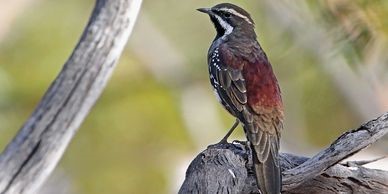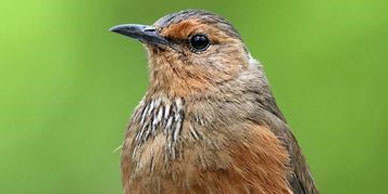BIRDING SITES IN SOUTH AUSTRALIA
Adelaide, South Australia, Australia
BIRDING SITES IN SA
Adelaide Region

There are a good wetlands and coastal areas north of Adelaide, notably the Greenfields wetlands and the Adelaide International Bird Sanctuary – important for migratory waders during our summer, as well as the endemic Banded Stilt. Rock Parrot and Slender-billed Thornbill are regularly seen here. To the east of the city the Mt Lofty Ranges contain a string of reserves, with Scarlet Robin, Yellow-tailed Black Cockatoo, Long-billed Corella, Adelaide Rosella, Musk and Purple-Crowned Lorikeet and others. A rich variety of Honeyeaters including Eastern Spinebill, Tawny-crowned, Crescent, etc. together with the rare Chestnut-rumped Heathwren and Crested Shrike-tit inhabit the area. To the south of the city is the Fleurieu Peninsula and coast. Wetlands, swamps, coastal reserves, native bushland and sea-watching spots attract birds such as Little Penguin, Hooded Plover, Cape Barren Goose, Southern Emu-wren, raptors, rails and crakes, waterfowl and migratory waders. Elegant and Rock Parrot may be seen here.
River Murray and Gluepot

The river Murray is lined with wetlands and floodplains which hold ducks, waders, rails and crakes; with key species such as Freckled, Blue-billed and Musk Duck, Banded Stilt, Baillon’s, Australian Spotted, Spotless Crake and Buff-banded Rail. In the Red Gums all along the river, Yellow Rosella and Regent Parrot are observed. On the higher grounds you find extensive areas of Mallee, the multi-stemmed eucalypt bushland covering much of the semi-arid regions. Birdlife’s Gluepot reserve, a vast expanse of mallee bushland, contains many rare and threatened birds such as Malleefowl, Red-lored Whistler, Chestnut Quail Thrush, Major Mitchell Cockatoo, Black-eared Miner, Striated Grasswren, Shy Heathwren Southern Scrub-robin, and occasionally Scarlet-chested Parrot. The surrounding, endless bluebush plains are home to White-winged Fairy Wren, Redthroat, Pied Honeyeater, Crimson and Orange Chat.
Yorke Peninsula, Pt Augusta

Innes NP on the tip of Yorke Peninsula is a stronghold for Western Whipbird, as well as Rock Parrot and Purple-gaped Honeyeater. Shy Heathwren, Southern Scrubrobin, Brush Bronzewing and Malleefowl can also be seen here. Further north the Remarkable Ranges hold Grey-fronted Honeyeater, Chestnut-rumped Heathwren while along the coast, Slender-billed Thornbill lives in the samphire flats. Around Port Augusta, good birding sites abound: the Arid Lands Botanical Gardens are a haven for honeyeaters while Redthroat and Chirruping Wedgebill are resident. The coastal salt lagoons often hold flocks of Banded Stilts. In the prairie-like plains of the Whyalla-Iron Knob area, Western Grasswren, Slender-billed Thornbill, Redthroat and the turquoise race of Splendid Fairy-wren can be found and at certain times small flocks of Orange or Crimson Chats.
Flinders Ranges & Outback

The Flinders Ranges, a spectacular small mountain range on the edge of the outback, are home to Ringneck, Elegant Parrot, Redthroat, Rufous Fieldwren, Short-tailed Grasswren, White-winged Fairywren and Grey-fronted Honeyeater. Heading north you start entering the outback, with species such as Chirruping Wedgebill, Pied Honeyeater, Crimson Chat, and Ground Cuckoo-shrike. Around Lyndhurst it’s true outback country: the endless stony plains of the Strzelecki desert is where the much sought-after Chestnut-breasted Whiteface, Thick-billed Grasswren and Cinnamon Quail-thrush live.
The outback can be hot, dry, and endless, but has a rich variety of species adapted to its harsh conditions. Along Birdsville track is Inland Dotterel, Banded Whiteface, Letter-winged Kite, Gibberbird,Thick-billed Grasswren and Cinnamon Quail-thrush are found. Further afield Eyrean and Grey Grasswren, Yellow Chat, Flock Bronzewing, Grey Falcon and Black-breasted Buzzard are much sought. When vast Lake Eyre irregularly fills, only a few times per century, it becomes an oasis in the desert with enormous numbers of breeding Banded Stilts and Australian Pelicans.
Download our SA Birding Site Guide
Eyre Peninsula & Nullarbor

On the Eyre Peninsula some western Australian species find their easternmost limit. These include Rufous Treecreeper, Western Yellow Robin and Blue-breasted Fairy Wren. Along the coast, check for Hooded Plover, Banded Stilt, Rock Parrot and migratory waders in summer. Around Port Lincoln, at the tip of the peninsula, look for Hooded Plover, White-bellied Sea-eagle, Eastern Osprey while the surrounding national parks are good for Western Whipbird and Southern Scrubrobin, Diamond Firetail, Shy Heathwren and Western Gerygone. Here you can also find Rock Parrot, Purple-gaped Honeyeater and Rufous Fieldwren.
North of the peninsula, the Gawler Ranges is where good mallee and outback species can be found. Its reserves contain Elegant Parrot, Copperback Quail-thrush, Striated and Short-tailed Grasswren. Heading west across the vast, treeless Nullarbor plain, the Nullarbor roadhouse is a reliable spot for Nullarbor Quail-thrush while Naretha Bluebonnet may be found in adjacent areas. Southern Right Whales congregate here in our winter months.
Download our SA Birding Site Guide
Kangaroo Island

Just off the Adelaide coast, Kangaroo Island harbours a unique, diverse wildlife, specialised birds, striking scenery (including remarkable granite formations) and vast wilderness, protected in many reserves. Kangaroo Island Kangaroos, tammar wallabies, echidnas, brush-tailed possums, bottle-nosed dolphins, Australian sea-lions, Australian and New-Zealand Fur Seals and many of the 260 birds listed for the island can be seen year round in their natural habitats. Key birds include the endangered Glossy Black Cockatoo, colonies of Short-tailed Shearwaters, Hooded Plover, Cape Barren Goose, Rock Parrot, the elusive Western Whipbird and the cute Fairy Penguin as well Bush Stone Curlew, Banded Stilt, Purple-gaped Honeyeater and many other sea and land birds. Kangaroo Island is easily accessible. Relatively small, it has beautiful secluded beaches, an impressive rocky coastline and many National Parks including mallee reserves. It is the only place in SA with a population of Glossy Black Cockatoos. There are a number of Fairy Penguin colonies. Seawatching can be good and may turn up rarities.